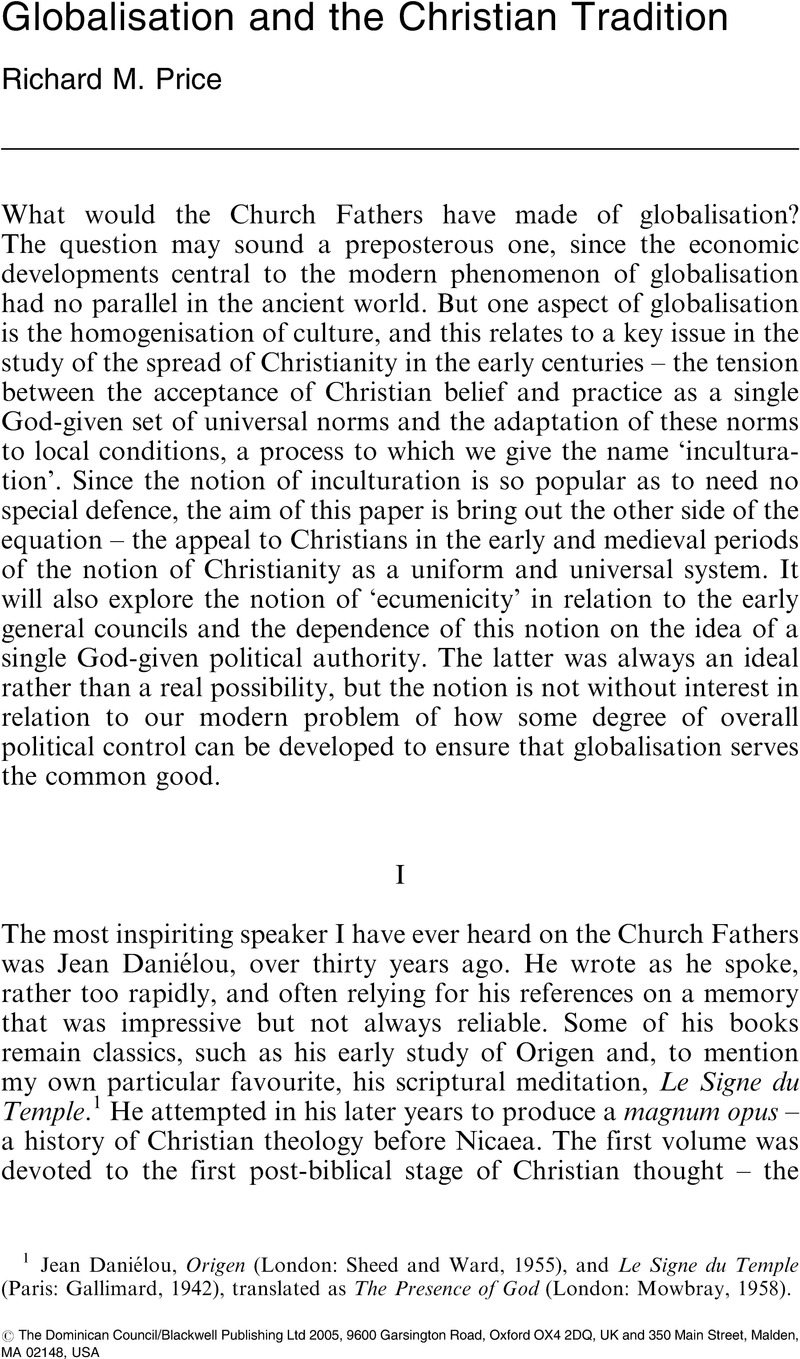No CrossRef data available.
Article contents
Globalisation and the Christian Tradition
Published online by Cambridge University Press: 01 January 2024
Abstract

- Type
- Catholic Theological Association 2004 Conference papers
- Information
- Copyright
- Copyright © The Dominican Council/Blackwell Publishing Ltd 2005
References
1 Daniélou, Jean, Origen(London: Sheed and Ward, 1955)Google Scholar, and Le Signe du Temple(Paris: Gallimard, 1942)Google Scholar, translated as The Presence of God(London: Mowbray, 1958)Google Scholar.
2 Daniélou, Jean, The Theology of Jewish Christianity(London: Darton, Longman & Todd, 1964)Google Scholar, Gospel Message and Hellenistic Culture(London: DLT, 1973)Google Scholar, The Origins of Latin Christianity(London: DLT, 1977)Google Scholar.
3 See Barr, James, Old and New in Interpretation: A Study of the Two Testaments(London: SCM Press, 1966)Google Scholar, ch. 2, ‘Athens or Jerusalem?– The Question of Distinctiveness’.
4 See Price, R.M., ‘“Hellenization” and the Logos Doctrine in Justin Martyr’, Vigiliae Christianae, 42 (1988), 18–23CrossRefGoogle Scholar.
5 MacMullen, Ramsay, Christianizing the Roman Empire, A.D. 100–400(Yale University Press, 1984), 25–42Google Scholar.
6 The most intelligent introduction to patristic biblical exegesis is Young, Frances, Biblical Exegesis and the Formation of Christian Culture(Cambridge University Press, 1997)CrossRefGoogle Scholar.
7 Duffy, Eamon, Saints and Sinners: A History of the Popes(Yale University Press, 1997), 6–12Google Scholar. The major study has now appeared in English: Lampe, Peter, From Paul to Valentinus: Christians at Rome in the first two centuries(London: Continuum, 2003)Google Scholar.
8 See McKitterick, Rosamond, ed, Carolingian Culture: Emulation and Innovation(Cambridge University Press, 1994)Google Scholar.
9 Fennell, John, A History of the Russian Church to 1448(Longman, 1995), 77–90Google Scholar.
10 Thomson, Francis J., The Reception of Byzantine Culture in Mediaeval Russia(Ashgate, 1999)Google Scholar.
11 See Fedotov, G. P., The Russian Religious Mind: Kievan Christianity, The Tenth to the Thirteenth Centuries(Harvard University Press, 1946), 244–60Google Scholar, and Obolensky, Dimitri, Six Byzantine Portraits(Oxford University Press, 1988)Google Scholar, ch. 3, ‘Vladimir Monomakh’.
12 Pamyatniki Literatury Drevnei Rusi, XI‐nachalo XII veka(Moscow, 1978), 394–96Google Scholar. The whole passage is a loose translation of the opening lines of St Basil the Great, Discourse on Asceticism(PG 31, 648C‐649A). The reference to women is an addition to Basil's text.
13 It was because Islam prohibits wine that the earlier Prince Vladimir had in 988 rejected it in favour of Christianity, as the Primary Chronicle tells us. Etiam peccata…
14 See Zumkeller, Adolar, Augustine's Ideal of the Religious Life(Fordham University Press, 1986)Google Scholar, and, on his attempt to combine the rejection of particular loyalties with some degree of realism, Price, R.M., Augustine(Liguori, Missouri: Triumph, 1996), 75–91Google Scholar.
15 For the role of emperors in summoning and ratifying the early ecumenical councils, as rulers of the oikoumene, see Chadwick, Henry, East and West: The Making of a Rift in the Church(Oxford University Press, 2003), 73–75CrossRefGoogle Scholar.
16 The wording is: ‘We acknowledge the living and holy Spirit, the living Paraclete, who [is] from the Father and the Son.’ See Bruns, Peter, ‘Bemerkungen zur Rezeption des Nicaenums in der ostsyrischen Kirche’, Annuarium Historiae Conciliorum 32 (2000), 1–22CrossRefGoogle Scholar.
17 Price, R.M., ‘The Holy Land in Old Russian Culture’, in Swanson, R.N., ed. The Holy Land, Holy Lands, and Christian History, Studies in Church History 36 (2000), 250–62Google Scholar.
18 See G.E.M. de Ste. Croix, The Class Struggle in the Ancient Greek World(London: Duckworth, 1981), 383–402Google Scholar, and Dagron, Gilbert, Emperor and Priest: The Imperial Office in Byzantium(Cambridge, 2003)Google Scholar.


